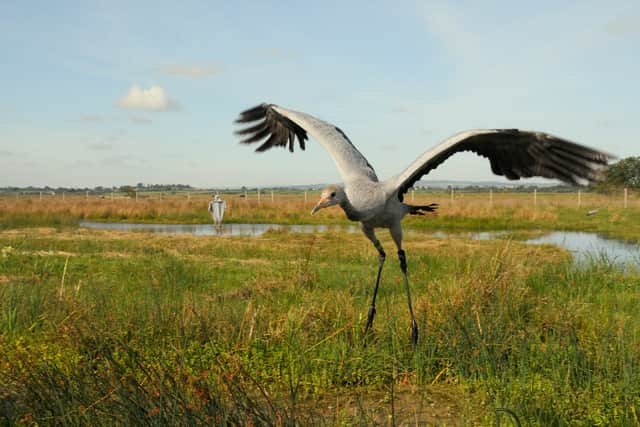Common cranes: Number of 'UK’s tallest bird' once wiped out hits record high - here's where to see them
and live on Freeview channel 276
In a dramatic comeback, numbers of the tallest bird to naturally grace the British Isles have hit a record high - after the species was once wiped from our shores.
New breeding survey results released on Friday (2 February) show 2023 was successful year for the common crane, with a record 80 pairs confirmed in the UK - and 36 young known to have fledged. This is the highest number since the species returned to UK's shores in 1979, after being driven to extinction in the 16th century by hunting and the loss of their favoured wetland habitats.
Advertisement
Hide AdAdvertisement
Hide AdThe common crane, listed as 'amber' on the UK's threat list for birds, can grow up to four feet tall, with a wingspan of more than two metres. Besides their height, the birds are also known for their graceful mating dance. When a pair comes together to start the breeding season, they reinforce their bond with an energetic dance of head bobbing, bows and pirouettes.


The wetland giants have made a dramatic comeback since their disappearance, beginning with just a handful of wild birds arriving to the Norfolk Broads. The population has continued to slowly rise, with 2023’s results beating the previous high of 72 pairs in 2021. The total UK population is now believed to be in excess of 250 birds - with numbers also boosted by a reintroduction project which saw hand-reared cranes released on the Somerset Levels.
Friday also marks World Wetland Day, and experts say that conservation efforts to restore and protect the species' favoured wetland habitats won't just help birds, but could also help protect communities from flooding by absorbing heavy rainfall - and lock away carbon to help combat climate change.
UK Crane Working Group chairman Damon Bridge said the conservation and protection of UK wetlands was helping the common crane population go "from strength-to-strength". "But that’s only part of the story. Wetlands support countless other magnificent species, lock-away carbon to fight climate change and can hold back water to help reduce the impact of flooding," he said.
Advertisement
Hide AdAdvertisement
Hide Ad“The continued success of these amazing birds is showing us that conservation action works. We need to build on this foundation by safeguarding protected sites and creating larger, better-connected wetland areas across the UK to fully reap the benefits this vital habitat can provide for nature and people.”
Wetland areas provide refuge to huge numbers of native and migrant birds, including cranes. Last year wetlands on the English east coast, spanning from the Humber to the Thames, were added to the UK’s list of potential World Heritage Sites due to their ‘outstanding universal value’. RSPB conservation scientist Andrew Stanbury added that a recent government announcement it would spend £16m rewetting and restoring peatlands across England was good news for the cranes, and countless other species.
"Investing in nature’s recovery benefits everyone," he said. "We must now go further and move faster, scaling up efforts to restore protected sites and landscapes by 2030 if wildlife and people are to thrive.”
Where can I see common cranes in the UK?
Nature reserves have played a vital role in the species' recovery, and over 80% of the breeding population are now found on protected sites - including over a third on RSPB nature reserves alone.
Advertisement
Hide AdAdvertisement
Hide AdWhile common cranes are naturally secretive during the breeding period and can be difficult to spot, they can be seen more easily at other times of year on a number of RSPB nature reserves. These include: West Sedgemoor, Lakenheath Fen, Nene Washes and Loch of Strathbeg, Norfolk Wildlife Trust’s Hickling Broad and Marshes nature reserve, and the Lincolnshire Wildlife Trust’s Willow Tree Fen nature reserve.
Comment Guidelines
National World encourages reader discussion on our stories. User feedback, insights and back-and-forth exchanges add a rich layer of context to reporting. Please review our Community Guidelines before commenting.
